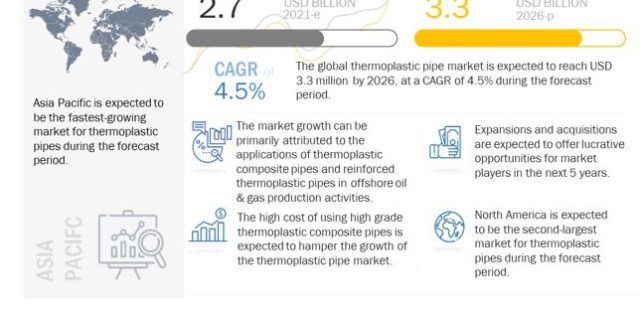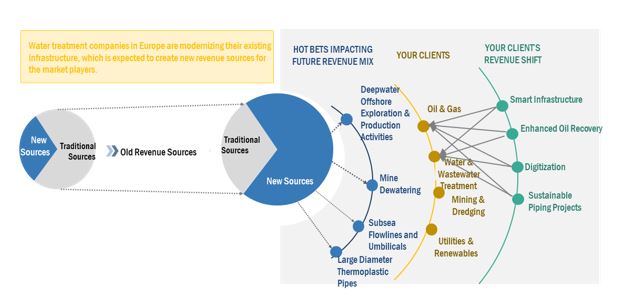
Thermoplastic Pipe Market New Revenue Pockets:
The global thermoplastic pipe market is projected to reach USD 3.3 billion by 2026 from an estimated USD 2.7 billion in 2021, at a CAGR of 4.5% during the forecast period. The global thermoplastic pipe market is driven by the increasing usage of engineered thermoplastic materials in manufacturing pipes.

The thermoplastic pipe market has promising growth potential due to the increasing application of thermoplastic composite pipes and reinforced thermoplastic pipes in offshore and onshore production activities. The oil & gas industry uses steel as a key material in manufacturing a variety of tubes and pipes. In the onshore industry, steel continues to be used dominantly in products such as coiled tubing and flow lines. However, thermoplastic composites are primarily used for offshore applications, such as chemical injection pipes and risers. Offshore drilling and production activities are expected to increase in the next five years at a greater pace than onshore activities, given the increasing importance of deep and ultra-deepwater oil & gas production and exploration activities, as demand for fossil fuels has intensified. Therefore, thermoplastic composites’ application in offshore products, such as flowlines, umbilical, and risers, is likely to drive the thermoplastic pipe market in the oil & gas industry.
Download PDF Brochure – https://www.marketsandmarkets.com/pdfdownloadNew.asp?id=94371234
This research report categorizes the thermoplastic pipe market based on Product Type, Polymer Type, End-User Industries, Application, and geography.
Based on Product Type, the thermoplastic pipe market has been segmented as follows:
- Reinforced Thermoplastic Pipes (RTP)
- Thermoplastic Composite Pipes (TCP)
Based on Polymer Type, the thermoplastic pipe market has been segmented as follows:
- Polyethylene (PE)
- Polypropylene (PP)
- Polyvinylidene Fluoride (PVDF)
- Polyvinyl Chloride (PVC)
- Others
Based on End-User Industry, the thermoplastic pipe market has been segmented as follows:
- Oil & Gas
- Water & Wastewater
- Mining & Dredging
- Utilities & Renewables
Based on Application, the thermoplastic pipe market has been segmented as follows:
- Onshore
- Offshore
Based on the Geography, the thermoplastic pipe market has been segmented as follows:
- North America
- Asia Pacific
- South America
- Europe
- Middle East & Africa
Speak to Analyst – https://www.marketsandmarkets.com/speaktoanalystNew.asp?id=94371234
The thermoplastic pipe market, by product type, is segmented into reinforced thermoplastic pipes (RTP) and thermoplastic composite pipes (TCP) The reinforced thermoplastic pipes (RTP) segment is likely to account for the largest size of the thermoplastic pipe market. The increasing usage of RTPs in the water & wastewater treatment industry is likely to fuel their demand globally.
The report segments the thermoplastic pipe market, by end-user industry, into oil & gas, mining & dredging, water & wastewater treatment, and utilities & renewables The oil & gas segment is likely to dominate the thermoplastic pipe market. Thermoplastic pipes are ideal for use in high pressure and deepwater applications in the oil & gas industry, which is expected to fuel the growth of the segment.
The thermoplastic pipe market, by polymer type, is categorized into polyethylene (PE), polypropylene (PP), polyvinylidene fluoride (PVDF), polyvinyl chloride (PVC), and others. The polyethylene segment held the largest share of the thermoplastic pipe market owing to its light weight, flexibility, and easy to weld properties.
Request FREE Sample Pages of the Report – https://www.marketsandmarkets.com/requestsampleNew.asp?id=94371234
South America is estimated to be the fastest-growing market for thermoplastic pipe during the forecast period. The growth of the South American market is driven by the increasing investments in the oil & gas industries in Venezuela and Brazil by foreign countries.


